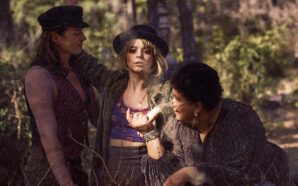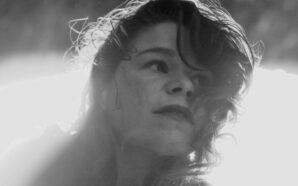Last Wednesday the Dandy Warhols played one of the best shows Philadelphia’s seen all year at the Trocadero. The show also holds quite a bit of sentimental significance for me. The last time the band played that particular venue was nearly nine years ago. It was the first concert I ever attended since moving to Philadelphia. Since then, I’ve gotten a bachelor’s degree from UArts, a master’s from Temple, become a “legit” music journalist, taken up semiotics, transformed myself into a college professor, been to probably around a thousand additional concerts, broken up a marriage, and fully realized my own penchant for Mozzian solitude… and, yet, I remain in the City of Brotherly Love and Sisterly Affection. However, I was well aware that the gig might not be quite so existentially heavy for the band themselves. I chatted with multi-instrumentalist (but primarily keyboardist) Zia McCabe before the performance and she admits that she doesn’t remember previously playing the room. Although when I tell her that not only was it a geographically significant show for me, but that it was also the longest show I’ve ever witnessed, she jokingly and musically muses, “Ohhh, it was ‘the three hour toooouuur,’ yeah, we can’t do that anymore…” She laughed when I told her that they beat out the first time I ever saw The Cure by about 20 minutes.
However, there was something existentially prolific to be gleaned from The Dandys latest Philadelphia appearance. I think The Dandy Warhols may be the most gracefully aging hipster mega-band of all-time… and I mean that in the best possible way. The Dandy Warhols are The Rolling Stones of hipsters. This April the band released their eighth studio album, This Machine. However, at their recent stop in Philthy, they didn’t seem to be so bent on selling their latest work but, simply, on putting on a performance that their longtime fans would enjoy. They weren’t shoving-down-the-audiences’-throats their latest output, but focusing on the neo-psychedelic indie pop “hits” that had gained them such an audience over their 18-year career. It was 10 songs into their more-than-twenty-song set before they even got to anything from their new album.
The Dandy Warhols opened the evening with “Be In,” the fuzzy opening track of 1997’s …The Dandy Warhols Come Down, before proceeding to play seven of the album’s 14 tracks throughout the course of the evening. The rest of the first half of their two-hour set was punctuated with, and largely comprised of, their neo-“urban”-bohemian anthems like “We Used to be Friends,” “Shakin’,” and “Not If You Were the Last Junkie on Earth.” Of course, it did include a handful of their hazier psych numbers, such as “I Love You” and “You Were The Last High,” but it’s not as if these tunes are any less sing-along-able than their more upbeat work.
The fans in attendance (who didn’t quite fill up the room… but weren’t exactly sparse either) were an interesting mix. There were individuals who seemed to think that the 1,200-capacity room was “so intimate,” who likely don’t make it out to more than half a dozen concerts a year. There were those lifelong fans who had always gone to see The Dandys on the road, who would always go to see The Dandys on the road (and always appreciate their greatness, even if our favorite memories are not-quite-recent). And there were even cargo-shorted individuals who probably primarily go to concerts in sheds, but recognize The Dandys as a band that pens tunes that should be as persuasive as anyone playing in arenas. However, all of the fans had one thing in common: everyone was happy to be there. There were no pretentiously critical fans, there were no bored fans, and there were no fans that felt as though they should have divine rights over the band’s setlist. Everyone seemed to be having the best time they had had in quite a while, dancing, singing, and drinking.
The band’s set was split in halves by “Every Day Should Be a Holiday,” which had lead vocalist and guitarist Courtney Taylor-Taylor taking on the 1997 song solo with all of his accompaniment from the audience, something the band has taken up in recent years that is coming to be quite an endearing staple. The performance was designed primarily to let the rest of the band pee and/or smoke, but it does ultimately appear as quite a touchingly intimate exercise. After that the band finally indulged in a handful of numbers from their latest release. However, they were then quickly back to their catchiest tunes of yesteryear (i.e. “Minnesoter,” “Get Off,” “Boys Better,” “Bohemian Like You,” which I think should be University of the Arts’ official “fight” song, and “Solid,” better known as “The-Theme-to-That-Judd-Apatow-Show-After-Freaks-and-Geeks-but-Before-he-was-Famous.)
The show was not the most prolific I’ve seen this year. I mean, the band’s performances themselves aren’t exactly transcendent and they’re not exactly uncovering new sonic formulas… at least not at this point in their career. However, it was the best sing-along I’ve attended, well… likely since the band was here last, in November of 2010, and the most fun I’ve had at a concert by a band that wasn’t attempting to channel Blondie in as long as I can remember. The Dandy Warhols are a band with hits and they’re not afraid to flaunt them… and from the band that, arguably, made Portland the hipster capital of the world, well, that’s actually quite charming.
So what’s next for The Dandys? “We would like to release a live album,” Zia tells me, which is well in the works and the band is hoping will be done and out by November. And beyond that? She tells me they’re “Preparing [themselves] for 2013, the 13th anniversary of 13 Tales from Urban Bohemia,” and, hopefully, a corresponding tour: “I’d really like to tour that album front to back.”
However, as is often the case with my interviews, our chat tended to focus not on the music, but her interests that fall into the realm of humanities-inspired thought. We got to chatting about the city of Portland, city-living, and city-planning. “I’ve always been really interested by inner city culture,” she tells me, “I mean, I grew up in a log cabin.” We go on to talk about the racial segregation of Portland. I tell her that I wasn’t even aware of black people living in Portland [beyond the Trailblazers… yeah, it’s that bad]. “It’s very segregated,” she tells me, “I was pretty much the first white person in my neighborhood when I moved there and I’m pretty much still the only white person.” She explains how the segregation isn’t necessarily as negative as it sounds, but a lot of it is due to the fact that the people in her neighborhood don’t abandon it or move on when they become financially successful, but that they stay and nurture it, pumping money and life into it, as opposed to keeping up with outside Joneses. As she goes on about her love of her neighborhood my head is reeling with the wisdom of Jane Jacobs’ The Death and Life of Great American Cities (a text I teach every semester in Temple’s Intellectual Heritage program) and I’m actually wondering if there is hope for Jacobsian “healthy” city neighborhoods, when Zia, who admits to being a somewhat typical PDX hipster (“I am one of those clichés.”), confesses, of herself and her peers, something that, more or less, confirms my hope: “I think white people want black people to think they’re cool. I mean, I want black people to think I’m cool.”










